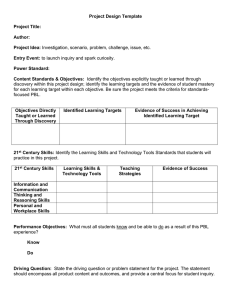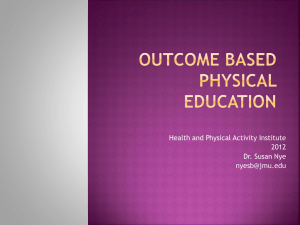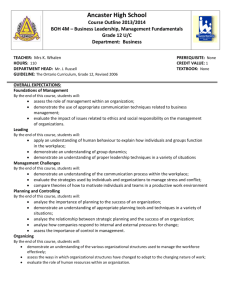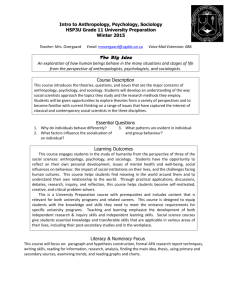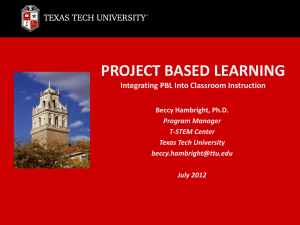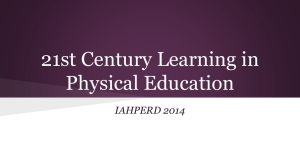PBL Project Design Rubric: Evaluate Project Quality
advertisement
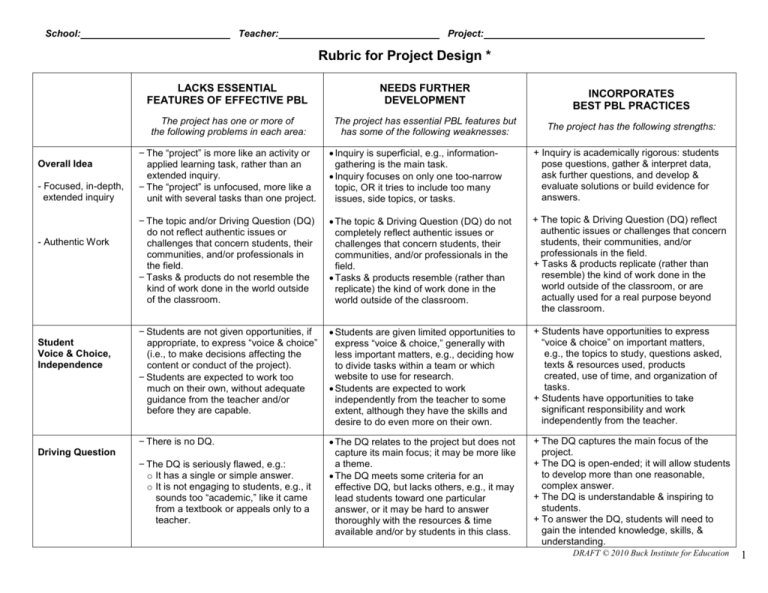
School: Teacher: Project: : Rubric for Project Design * LACKS ESSENTIAL FEATURES OF EFFECTIVE PBL NEEDS FURTHER DEVELOPMENT The project has one or more of the following problems in each area: The project has essential PBL features but has some of the following weaknesses: - The “project” is more like an activity or Overall Idea - Focused, in-depth, extended inquiry applied learning task, rather than an extended inquiry. - The “project” is unfocused, more like a unit with several tasks than one project. - The topic and/or Driving Question (DQ) - Authentic Work do not reflect authentic issues or challenges that concern students, their communities, and/or professionals in the field. - Tasks & products do not resemble the kind of work done in the world outside of the classroom. - Students are not given opportunities, if Student Voice & Choice, Independence appropriate, to express “voice & choice” (i.e., to make decisions affecting the content or conduct of the project). - Students are expected to work too much on their own, without adequate guidance from the teacher and/or before they are capable. - There is no DQ. Driving Question - The DQ is seriously flawed, e.g.: o It has a single or simple answer. o It is not engaging to students, e.g., it sounds too “academic,” like it came from a textbook or appeals only to a teacher. INCORPORATES BEST PBL PRACTICES The project has the following strengths: Inquiry is superficial, e.g., informationgathering is the main task. Inquiry focuses on only one too-narrow topic, OR it tries to include too many issues, side topics, or tasks. + Inquiry is academically rigorous: students pose questions, gather & interpret data, ask further questions, and develop & evaluate solutions or build evidence for answers. The topic & Driving Question (DQ) do not completely reflect authentic issues or challenges that concern students, their communities, and/or professionals in the field. Tasks & products resemble (rather than replicate) the kind of work done in the world outside of the classroom. + The topic & Driving Question (DQ) reflect authentic issues or challenges that concern students, their communities, and/or professionals in the field. + Tasks & products replicate (rather than resemble) the kind of work done in the world outside of the classroom, or are actually used for a real purpose beyond the classroom. Students are given limited opportunities to express “voice & choice,” generally with less important matters, e.g., deciding how to divide tasks within a team or which website to use for research. Students are expected to work independently from the teacher to some extent, although they have the skills and desire to do even more on their own. + Students have opportunities to express “voice & choice” on important matters, e.g., the topics to study, questions asked, texts & resources used, products created, use of time, and organization of tasks. + Students have opportunities to take significant responsibility and work independently from the teacher. The DQ relates to the project but does not capture its main focus; it may be more like a theme. The DQ meets some criteria for an effective DQ, but lacks others, e.g., it may lead students toward one particular answer, or it may be hard to answer thoroughly with the resources & time available and/or by students in this class. + The DQ captures the main focus of the project. + The DQ is open-ended; it will allow students to develop more than one reasonable, complex answer. + The DQ is understandable & inspiring to students. + To answer the DQ, students will need to gain the intended knowledge, skills, & understanding. DRAFT © 2010 Buck Institute for Education 1 - The project is more like “parallel Interdisciplinary Features teaching” with the same theme but with different products in each subject. (If Applicable) Content Outcomes - Content outcomes are not specified. - Content outcomes are not aligned with national, state, or district standards. - The development of 21st Century Skills st 21 Century Skills is not included. - It is assumed that some 21st Century Skills will be gained by students, but the project does not explicitly scaffold the development of these skills. - Collaboration - Students do all project tasks as individuals. - Presentation & Defense - Critical Thinking - Technology - Students do not present or defend their culminating product(s). - Students are not asked to think critically or solve problems. - Technology is not used, or is used inappropriately, e.g.: o It distracts or is unnecessary. o It takes too much time away from gaining other skills & key content knowledge. Different content areas make simplistic and/or limited contributions to the overall project (e.g., the math teacher helps with calculations or the English teacher helps with writing). In some subjects the project may not focus on key standards of the discipline. + Each content area makes substantive contributions to the project, e.g., the products students create require the integration of knowledge & skills from different disciplines. + Teachers of different subjects use the project to teach important parts of their curriculum. + If the project is centered around one subject, it is because other subjects plan to take turns being the major substantive focus of various projects. There are too few OR too many content outcomes The project emphasizes additional standards that students do not need to know to complete project tasks. + Specific content outcomes are aligned with key national, state, or district standards, and represent essential skills and understandings needed to successfully complete the project. Too few or relatively unimportant 21st Century Skills are targeted, OR too many to be adequately taught & assessed. The project scaffolds the development of 21st Century Skills to some extent, but there may not be adequate opportunities to build skills or rigorously assess them. + A limited number of important 21st century skills are targeted to be taught & assessed. + There are adequate opportunities to build 21st Century Skills and they are rigorously assessed, e.g., with a rubric and feedback. Students work in teams, but it may be more cooperative than collaborative, e.g. the work of individuals is pieced together. Students present their culminating products, but their defense is limited to a short, superficial question/answer session. Students are asked to analyze & solve problems and think critically, but not in depth or in a sustained way. Some technology is used, but more could be added to build engagement & skills and improve the quality of student work. + Students work in collaborative teams that employ the skills of all group members when completing project tasks. + Students may collaborate with people beyond the classroom. + Students present culminating products and defend them in detail & in depth, e.g. by explaining reasoning behind choices they made, their inquiry process, etc. + Students are asked to analyze & solve problems and think critically, in depth and in a sustained way. + Technology enhances the project in especially creative ways and/or in ways that greatly improve the quality of student skills, engagement, and work. DRAFT © 2010 Buck Institute for Education 2 - No major/culminating products are Major/Culminating Product(s) and Presentation Audience included, only a series of smaller assignments. - The major products are not aligned with the Driving Question, i.e., they do not answer it or solve the stated problem. - Students do not present or exhibit their work to an audience. Entry Event - No entry event is planned. - Day one of the project will feel like any other day (or worse, because it seems like more work than usual). - The project has no formative Formative Assessment assessment to monitor student learning prior to the submission of final products. - No summative assessments are Summative Assessment planned. - There are no summative assessments of individual student learning; e.g., all grades are determined by team-created products. - Expectations about the quality of work required are not communicated to students through rubrics and other methods. - Time frame is too short to accomplish Duration project tasks. - The project is too long to justify what is gained. Major/culminating products address the Driving Question, but do not align closely enough with standards & other outcomes (i.e., will not provide adequate evidence of learning). Students are asked to create products that are mainly replications of others’ work, e.g., a report of information or an artifact based on a model. + Major/culminating products provide an answer to the Driving Question and align with standards & other outcomes. + Major/culminating products require innovation; students create something new, e.g., a written product, piece of media or art, or their own presentation after analysis of information or synthesis of ideas. The audience for student presentations is limited to classmates & the teacher. + Students present or exhibit their work to an audience that includes other people from both within and outside the school, which may include online audiences. The entry event will gain student attention but it will not begin the inquiry process by creating a “need to know” or generate questions about the topic of the project. + The entry event will powerfully engage students, both emotionally & intellectually (i.e., make them feel invested in the project & provoke inquiry). Assessments are not used often enough to identify student learning needs or difficulties with project work. Assessments do not cover all essential content & skills. + Assessments frequently monitor student learning of important content & skills and student work on project tasks, so the teacher can improve instruction. + Assessments provide information to students so they can create high-quality products through critique & revision. Summative assessment focuses on only one major product. Expectations about the quality of work required are not clearly communicated to students, e.g., rubrics are unclear or incomplete. + Summative assessment focuses on both team-created products and individual learning, with the proper weight for each. + Summative assessment targets all important content & skill outcomes. + Expectations about the quality of work required are communicated to students through rubrics and other devices. + Rubrics are complete and of high quality. + Product exemplars are created or found, to illustrate the quality of expected work. Time frame may be overly optimistic about how quickly some tasks can be done. The project is too stretched-out; students become disengaged or unfocused. + The project is long enough to adequately answer the Driving Question and complete high-quality work, including time for revision, presentation, and reflection. * NOTE: This rubric may be used when a project is being planned, to fine-tune its design, or after it is conducted, as a design review. Use BIE’s forthcoming Project Implementation Rubric after the project to assess outcomes and the quality of implementation, including the degree to which learning goals were met and students were engaged, and how well time was used, teams were managed, lessons and other scaffolding were provided, and an effective classroom culture was developed. DRAFT © 2010 Buck Institute for Education 3
